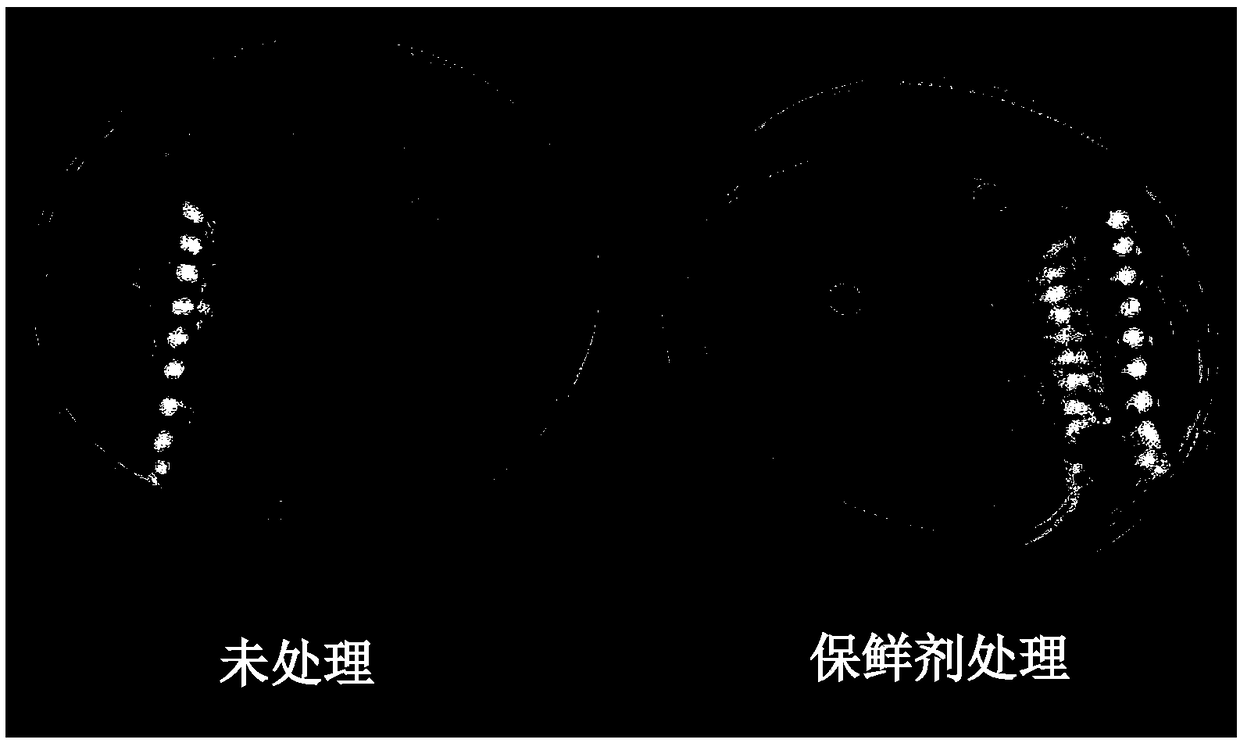Method used for preventing galangal post-harvest mildewing
A galangal and mold technology, applied in the application, preservation of food ingredients as anti-microbial, protection of fruits/vegetables with a protective layer, etc. Slow and other problems, to achieve the effect of promoting industrialization development, reducing environmental problems, and low cost
- Summary
- Abstract
- Description
- Claims
- Application Information
AI Technical Summary
Problems solved by technology
Method used
Image
Examples
Embodiment 1
[0027] Follow the steps below to prevent postharvest mildew in galangal:
[0028] Step 1: Harvest fresh galangal and cut it into sections, spray, soak or smear it with a preservative (25% of the weight of galangal) for prevention, make it even, spread out and dry until the surface of the galanga is dry.
[0029] The antistaling agent used to prevent mold pollution after the galangal is harvested consists of the following components in parts by weight: 65% of galangal stem extract treated with lactic acid bacteria; 1% of sodium hypochlorite, 0.25% of sodium benzoate, and the rest is water.
[0030] The galangal stalk extract treated with lactic acid bacteria is obtained by the following steps: Harvest fresh galangal stalks, perform water extraction at a material-to-liquid ratio of 1:5 by weight, then cool the extract, and add 10% by weight % lactic acid bacteria liquid fermentation 12h.
[0031] Step 2: Dry once (dried at 40°C) until the water content is lower than 40-50%, sli...
Embodiment 2
[0034] Follow the steps below to prevent postharvest mildew in galangal:
[0035] Step 1: Harvest fresh galangal medicinal material and cut into sections, spray, soak or smear with preservative (35% of the weight of galangal ginger) for prevention, make it even, spread out and dry until the surface of the medicinal material is dry.
[0036] The antistaling agent used to prevent mold pollution after the galangal is harvested is composed of the following components in parts by weight: 35% of the galangal stem extract treated with lactic acid bacteria; 3% of hypochlorous acid, 0.15% of sodium benzoate, and the rest is water .
[0037] The galangal stalk extract liquid treated by lactic acid bacteria is obtained through the following steps: harvest fresh galangal ginger stalks, carry out water extraction through a material-to-liquid ratio of 1:8 by weight, then cool the extract solution, and add 5% by weight % lactic acid bacteria liquid fermentation 24h.
[0038] Step 2: Dry on...
Embodiment 3
[0041] Follow the steps below to prevent postharvest mildew in galangal:
[0042] Step 1: Harvest fresh galangal and cut it into sections, spray, soak or smear it with a preservative (40% of the weight of galangal) for prevention, make it even, spread out and dry until the surface of the galangal is dry.
[0043] The antistaling agent used to prevent mold pollution after the galangal is harvested is composed of the following components in parts by weight: 55% of galangal stem extract treated with lactic acid bacteria; 2% of sodium hypochlorite, 0.25% of sodium benzoate, and the rest is water.
[0044]The galangal stalk extract liquid treated by lactic acid bacteria is obtained through the following steps: harvest fresh galanga stalks, carry out water extraction by a weight ratio of 1:10, then cool the extract solution, and add 10% by weight % of lactic acid bacteria bacterial liquid fermentation 18h.
[0045] Step 2: Once dried (naturally dried) until the water content is low...
PUM
 Login to View More
Login to View More Abstract
Description
Claims
Application Information
 Login to View More
Login to View More - R&D
- Intellectual Property
- Life Sciences
- Materials
- Tech Scout
- Unparalleled Data Quality
- Higher Quality Content
- 60% Fewer Hallucinations
Browse by: Latest US Patents, China's latest patents, Technical Efficacy Thesaurus, Application Domain, Technology Topic, Popular Technical Reports.
© 2025 PatSnap. All rights reserved.Legal|Privacy policy|Modern Slavery Act Transparency Statement|Sitemap|About US| Contact US: help@patsnap.com



